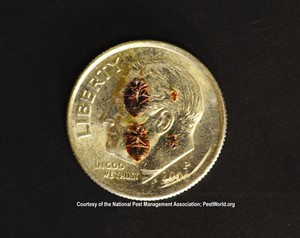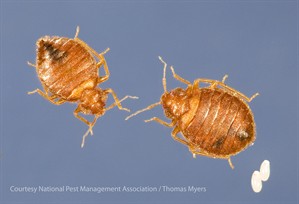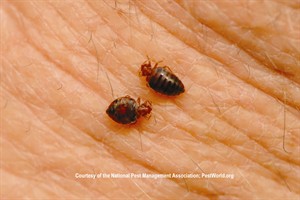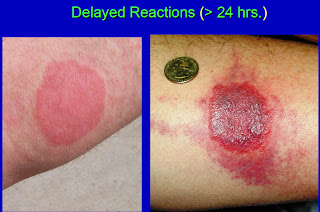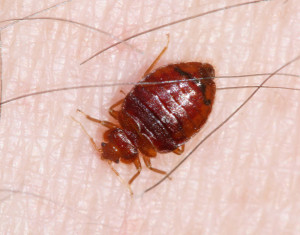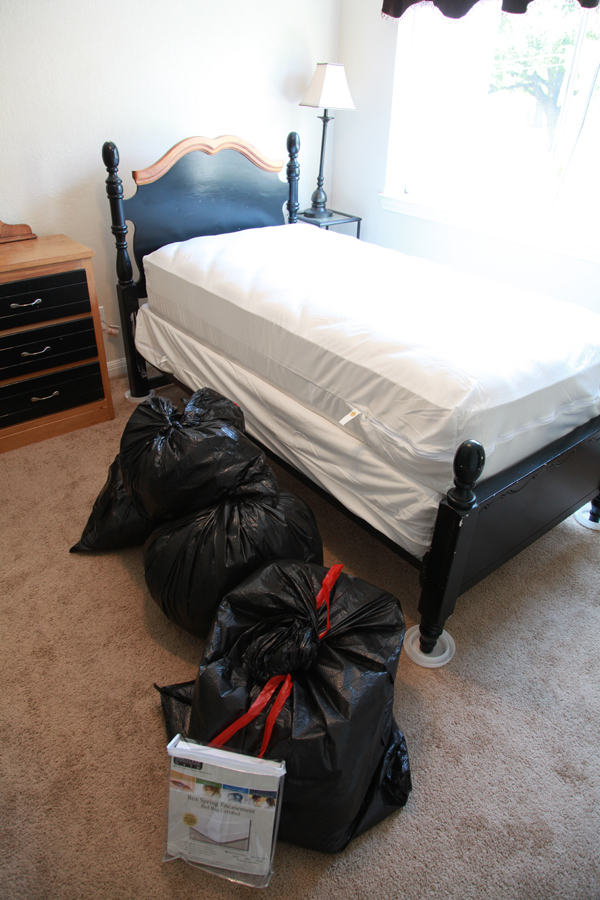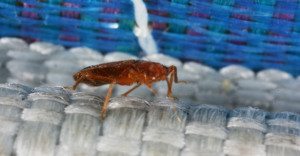Bedbug Q & A's
Dini M. Miller, Ph.D., an associate professor in Urban Pest Management at Virginia Tech's Department of Entomology answered some of the questions viewers e-mailed Dateline after the report on bed bugs. Read below.
On preventing bites, hair
Question: If you put on "Off" or some other insect repellant before retiring in a hotel will this prevent them from biting? Can they get in your hair? --Dolores Hill, Bessemer, Ala.
Answer: Although we have not specifically tested mosquito repellants on bed bugs, we have tested repellant insecticides. Bed bugs do not seem to respond in the slightest to repellent insecticides. In fact, they will sit on top of them until they die. These results have been confirmed by the older bed bug literature (Usinger 1966) who stated that many repellant materials were applied to bed frames in an attempt to keep bed bugs from crawling up, but none had any effect. Because we have not tested repellants on skin, we can’t say for sure whether bed bugs would be willing to stick their mouth parts though repellant treated skin or not. But we have found bed bugs to be very determined little creatures and I think it would be hard to stop a hungry bed bug. In addition, the repellants that you buy for mosquitoes last only a couple of hours before the effects begin to wear off. If you apply a repellant before getting into bed, a lot of the material could rub off on the sheets etc. Also, bed bugs are most active between 3 and 5 am, which is several hours after the time you would have put the on the repellant to go to bed. Bottom line, a repellant may prevent you from getting a bite or two but I do not believe that they will significantly hinder a hungry bed bug.
Bed bugs can get in your hair but the good news is that they really don’t want to be there. Unlike fleas and lice that have bodies or claws that are specifically designed for navigating through hair, the common bed bug does not have these modifications. In fact, bed bugs need to set their front claws in a particular position so that they can insert their mouthparts into the skin just so, in order to be in the proper feeding position. Hair on the human head would make this very difficult. They would much prefer to feed on the bare skin. If they encountered your head first, they would most likely move to your face (many people suffer face bites) or some other less hairy area to feed. If you are bald, well, the head is fair game.
On sleep sacks
Question: Would the silk “sleep sacks” sold as a travel accessory be any help at all against bed bug bites at a hotel? --L Hart , Irvine, Calif.
Answer: Unlikely. Bed bugs can very probably feed directly through the weave of the “sleep sack.” Even if the bag were to offer some protection, the bed bugs could crawl to the opening of the sack and enter that way. The best defense is to inspect the bed (mattress and sheets) and the head board for signs of bed bugs. If you find any, report this to the management and request a different room.
On Lysol
Question: When traveling I carry a can of Lysol spray and spray the bed with it. Is this helpful in getting rid of bed bugs? --Ennis, Tex. Answer: The only way that Lysol spray could help you is if you sprayed the bugs directly. The alcohols and propellants would probably kill bed bugs if you wetted them down with the material. However, dried spray on or around the bed would have no effect.
If you are traveling, always inspect your mattress for bed bugs by pulling back the covers and looking carefully at the seams and tufts for bed bugs or bed bug evidences (black fecal spots). If you find bed bug, don’t spray them yourself. This may cause them to move around and infest other areas. Instead, contact the hotel management inform them of the bugs and ask for another room immediately. Leave the spraying to a professional.
On bed bug spray Question: Are the pesticide companies trying to develop an effective bed bug spray? --Diana Shea, Descanso, Calif. Answer: This is an excellent question. All pesticides that are labeled for use in the United States have to be registered by the EPA. To get an EPA registration, the pesticide product has to be thoroughly tested for acute and chronic effects on mammals (laboratory rats and dogs), the potential effects on birds, fish, and honeybees has to be documented, and the environmental fate (half-life) of these products in water or soil also must be quantified. The cost of having a product registered is now estimated to be around $ 100 million. This cost naturally limits the number of products that make it to the marketplace. In addition, there has been a 10 to 15 year trend in reducing the number of pesticide products that receive registration for use in the indoor environment. In short, it is very hard to get new pesticides registered that are labeled for indoor use (as opposed to agricultural use).
Waking up with bed bugs However, throughout this trend of limiting indoor pesticides, we were bed bug free. Like the EPA, many people have concerns about applying chemicals where children sleep or play. But, if bed bugs should become as big a problem as they were at the beginning of the 20th century, the public may demand that the federal government register products that are effective against bed bugs. We will just have to wait and see. At this time, we do not know of any product that is in development specifically for bed bug control.
Question: Why is it that I get bit but my husband does not? --Denise, Indian Trail, N.C. Answer: Bed bugs tend to aggregate together when they are resting. It is possible that you are on the “bed bug side” of the bed. Bed bugs don’t switch back and forth from one host to another so if they find you first, you may be the only one bitten. It is also possible that your husband is getting bitten but does not have a significant reaction to the bed bug bites.
On where they bite
Question: Will a bed bug ever bite a reproductive body part? --Tyler P., Brookfield, Conn. Answer: Yes. They do not discriminate; any body part that is accessible and with good blood flow is fair game to a bed bug.
Bed bugs on cruise ships?
Question: I’m getting ready to go on a cruise, should I be concerned about bed bugs there? --Debbie Answer: Because we know that bed bugs are an increasing problem (some would call it an epidemic), it is prudent to inspect any location away from home where you are planning to sleep. Inspect your cabin thoroughly, looking for signs of bed bugs prior to unpacking. Look behind the head board if possible, and inspect your mattress. There is no need to tear the room apart, but a close look at the mattress seams and inside the cabin drawers prior to putting away your clothes should become part of your traveling routine.
Editor's note: Dateline did receive some e-mails with anecdotes from cruise ship goers who say they were bitten.
On treating bites
Question: Once a person has been bitten by a bed bug, how does one treat it? Lotions? Creams? -- Rachelle Berven, Denver, Colo. Answer: First, do not scratch it. Just like mosquito bites, scratching makes the reaction much worse. Instead wash the area with warm soapy water and then apply an anti-itch cream (examples: Benadryl cream or Hydrocortisone cream).
Do kinds of beds matter?
Question: Can you have bed bugs if you have a water bed? --E. Merlino, Rockville Centre, N.Y.
Answer: Absolutely, you can have bed bugs anywhere in a room (behind pictures hanging on the wall or in popcorn ceilings) because the attractant is not the bed itself but the warm blooded person that lays in it quietly for hours at a time. We have seen bed bugs in many types of beds: egg foam, sleeping bags, or stacks of cardboard on the floor. We have also seen them in a metal frame with a blanket over it, and even a balled up jacket in a corner that someone was using as a pillow. Basically, they can infest anything that people sleep on. I think the bed bugs might enjoy a water bed. Water bed frame typically have many nooks and crannies where bed bugs can hide and the heater would keep them quite comfortable.
Question: Can bedbugs also live in visco-memory foam beds? I have read some claims online that say that the bedbugs cannot get into the foam beds.
Answer: Remember that bed bugs get on mattresses and harbor and under the sheets in the seams and tufts. While they may not be able to get into the actual foam, it hardly matters. They can harbor on the foam, in the seams of the mattress cover or in the bed frame. Remember the mattress itself is not the bed bug attractant, the host that uses it is. So bed bugs do not have to live inside the mattress in order to feed on you at night. They might crawl down from the picture frame hanging above your bed or from some other location.
Question: A similar question has to do with mattress covers, can they prevent bed bugs?
Answer: The answer is no. Bed bugs can still get on top of the mattress cover or harbor in the bed frame. The advantage of the mattress cover is that if you already have bed bugs, you can trap them inside the cover and they cannot bite through. If you don’t have bed bugs the cover saves you from having to throw out the mattress if you ever get bed bugs.
On trauma, psychological impact
Question: My husband recently stayed at a very reputable hotel and was bitten by bed bugs, he has been so severely traumatized that he is not only having me wash the bedding and clothes everyday, he has to inspect the bed several times before he is okay to get in it. He also continues to wake up in the middle of the night throw back the covers and flip the light on just to make sure there are no bugs in the bed. He has even gone so far as to buy a pair of magnifying goggles with lights and an extra magnification lens just to be able to inspect our bed. This is driving me insane! What can I do to help him? He is not a man who is easily bothered or effected by things like this normally, but after his (one night)encounter with the bed bugs he is truly freaked out. I need help! --Lezlie H., Navarre, Fla. Answer: One of the things that I tell everyone about bed bugs is DON’T FREAK OUT! Why? Because it does not effect the bed bugs one bit. Not a bit. They could care less, those self-centered little creatures.
That being said, I understand that bed bugs can cause a lot of stress, and you can best help your husband by dealing with the problem calmly and systematically. Is your husband still experiencing bites? If not, it is quite possible that he did not bring any home. If he is experiencing bites, you should contact a pest control operator to inspect the room for bed bugs. If you are not sure if he is getting bitten, I suggest using bright white bedding (sheets and pillowcases) and using them on the bed for a week or more, so that you can more easily see blood spots (black specs) that might be left by feeding bed bugs. If after a week or more you do not see any signs of bed bugs, you can reassure your husband that he may have been fortunate and didn’t bring any home with him.
On elder care
Question: I am writing from Ma. My mother lives in elderly housing and has been dealing with this for about a year now. For the longest time she had none and did all the precautions that she could, but finally they arrived at her apartment. They did the extermination and had to remove her sofa, luckily they did not make it to her bedroom. Right now she has none and was recently checked but she lives with everything in plastic bags and the fear that they will be back. The problem though is that they are not doing all the apartments as I feel they should. They do one at a time as they are found you could say. They wash the tenants clothes for them and exterminate. The problem though is that most of these tenant’s are elderly, some their vision is not the best and have no idea what to look for and unless something is said they don’t go in and always check. My question is how do I get the city to listen and take more affirmative action. I have talked to some employee’s but it is always the same thing, “ they are working on it” and of course my mother doesn’t want to say or do too much in fear of being shunned, embarrassed, or doesn’t want to cause waves as she says. Hopefully someone can tell me what more I can do to help her and the other tenants with this problem. Thank you for your time. --Joy B., Swansea, Mass. Answer: Dealing with bed bugs in a “sensitive” environment is particularly difficult. First, I tend to agree with the management that pesticide applications have to be made on a case by case basis. Elderly people are known to be particularly sensitive to bronchial contaminants and applications of pesticide as a preventative measure may be more dangerous to these people than the bed bugs themselves. If pesticide is applied in an apartment that does not have bed bugs and someone gets sick, the apartment management could be in serious trouble. Currently, bed bug treatment is pesticide intensive with several products being used multiple times. Even so, these treatments may not be 100% successful. So how do we protect the elderly from bed bugs using as little pesticide as possible? The immediate answer is, do not simply rely on the apartment management or the pest control company to take care of the bed bug problem. You must play a role as well. Bed bugs are everyone’s problem, and you may have to be the monthly inspector for your mother if she cannot do it herself. Next, ask the apartment manager to put you in touch with the pest control company. Ask that company to give you, the apartment staff, and the tenants a training seminar in how to inspect for bed bugs. Most companies will gladly do this. They need all the help they can get. If the company won’t help you, call the health department and ask them if they would be willing to train the apartment staff and the tenants how to inspect for bed bugs. If the apartment staff is reluctant to put you in touch with the pest management company or refuses to attend the bed bug training, you can remind them about the bed bug lawsuits taking place all over the country and the bad press involved with these lawsuits. I believe that in the future the success of surviving a bed bug lawsuit will depend on whether or not a facility has a bed bug inspection policy in place. Give the apartment management the opportunity to act in good faith. They might think your bed bug training seminar is an excellent idea.
On city policies
Question: Bed bugs have been found in my daughter’s “industrial loft” apartment in Brooklyn, NY. The landlord has treated one room at a time with insecticide spray and floor varnish, yet not all spaces in the apartment have been treated at the same time. Other apartments on the same floor have also been found to have bed bugs. Is there any remedy or effective treatment to rid the building of the bed bugs? Also, what can a person take to reduce the reaction to the bites? Does the county or city have an extermination policy for rental units? --Margaret S., Buffalo, N.Y.
Answer: At this time we are not very good at curing bed bug problems. There is no pesticide or application method that works 100 percent of the time. Depending on the clutter that may exist in each apartment, treatment can have variable success. Bed bugs are very tough and the more clutter there is, the easier it is for bed bugs to hide away from the treatment. Sanitation efforts on the part of the resident may need to be extreme to get good bed bug control. So bed bug management requires just as much cooperation from the occupants as from the management and pest control company. Actual treatment requires patience and persistence. Treatment usually requires multiple products being applied at least 3 times at 2 week intervals. So, bottom line: treating an entire building will require all tenants and management to join in a cooperative, ongoing to inspect for bed bugs on a regular basis and keep sanitation levels high so that bed bugs problems do not get established. Is this cooperation a possibility in your daughter’s loft?
Question: Is there any remedy or effective treatment to rid the building of the bed bugs?
Answer: Fumigation has been tried but with limited success and the cost is usually more than $20,000, a lot more.
